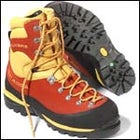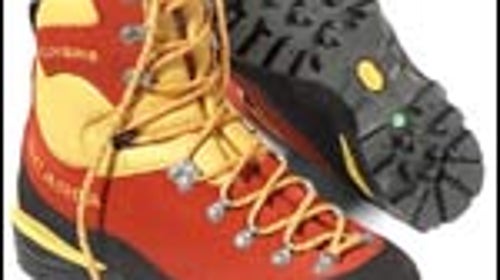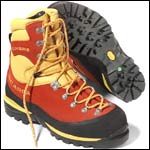The boot part is pretty easy to answer. The heel part is not. It could be you have a somewhat narrow heel (I do as well) which, combined with the relative stiffness of most boots suitable for ice climbing, means that the heel is going to slip around some. More on that in a minute.
 Scarpa Cumbre
Scarpa Cumbre
As for the boot, there are several excellent choices. Plastics remain popular, of course, and the Scarpa Inverno ($300, www.scarpa-us.com) is a fine choice for all-around glacier work. Maybe a little clunky on mixed terrain, but no worse than other plastics. Very warm and comfortable.
A lot of the exciting action, though, is in the new generation of leather boots. Scarpa is in this game, too, with the superb Cumbre ($435), which uses waterproof leather and Primaloft insulation to create a boot that’s flexible, good for ice or mixed terrain, and very warm. Salomon’s Pro Thermic ($390, www.salomonoutdoor.com) is a similar boot, offering great performance in a boot that mixes leather with insulation and a stiff climbing sole. And there’s Montrail’s I.C.E. 9 ($350, www.montrail.com; $185 for compatible crampon), a leather ice-climbing boot with an integrated (and of course removable) crampon for better fit and performance than a boot that has another maker’s crampon attached to it.
I’d try several boots of this type and see which maker has the best heel fit. You might also find that an after-market insole can soak up some extra space in the boot, giving your foot a snugger ride.
Happy climbing!
Read Mark Jenkins’ Hard Way column for an account of ice climbing the Icelandic way.


